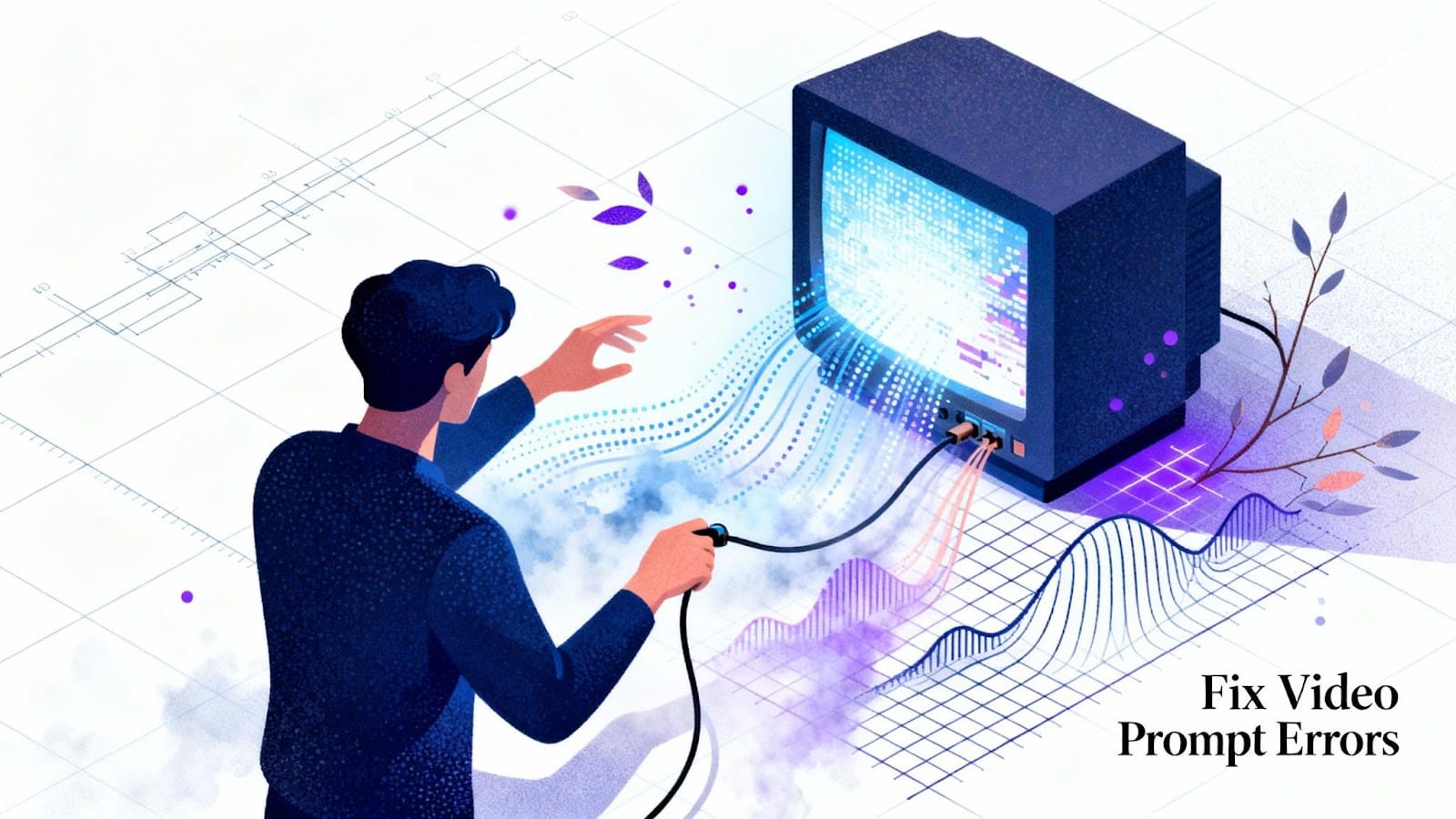How to Fix “Can't Generate Your Video. Try Another Prompt”
Learn actionable solutions to fix “can't generate your video. try another prompt” errors and generate high-quality videos using Segmind models and tools.

AI video generation has transformed how creators, marketers, and developers produce content, offering faster, scalable solutions than traditional methods.
Yet, many users encounter frustrating errors like “can't generate your video. try another prompt,” which halt their projects unexpectedly.
These failures often stem from unclear instructions, model limitations, or technical issues, leaving users unsure how to proceed.
This guide provides clear, actionable solutions to fix common video generation errors, optimize prompts, and leverage the right tools for consistent results.
Key Takeaways
- Prompt Smart, Generate Smooth: Clear, structured prompts prevent errors and ensure consistent video outputs.
- Choose the Right Tools: Using Segmind models and PixelFlow workflows streamlines generation and minimizes failures.
- Optimize & Troubleshoot: Technical checks, proper settings, and platform-specific fixes keep projects running without hiccups.
- Build for Long-Term Success: Maintain prompt libraries, fine-tune models, and monitor updates for reliable, high-quality video creation.
What That “Can't Generate Your Video” Message Really Means
This error generally indicates that the AI platform could not interpret your prompt successfully or encountered a system-level limitation.
It doesn’t always mean the request is invalid; often, the model struggles with unclear instructions, overly complex scenarios, or content that violates platform policies.
Why AI Video Generation Fails
1. Prompt Interpretation Challenges
Ambiguous or vague prompts can confuse the model, producing errors instead of videos.
For example, using conflicting instructions like “sunset in winter with tropical beach vibes” may exceed the model’s understanding.
2. Model Limitations and Training Gaps
Each AI model has specific strengths and constraints. Some models excel at simple, single-scene videos, while others handle complex, multi-scene storytelling.
If the requested output falls outside the model’s training data or capacity, failures are likely.
3. System Capacity Constraints
AI video generation requires significant computing resources. Platform overloads, GPU limitations, or server downtime can result in errors.
Segmind addresses this with Segmind Cloud, offering elastic GPU scaling to handle heavy workloads and maintain smooth video generation even under high demand.
Tip: Use PixelFlow to test and combine multiple models seamlessly. This not only refines outputs but also prevents errors caused by misaligned prompts or model constraints.
Common Triggers Behind Video Generation Failures
The most frequent cause of failures is the prompt itself. Ambiguous, overly complex, or contradictory instructions can prevent the model from generating video. Examples include:
- Vague Instructions: Phrases like “make a cool video” lack detail for the model to interpret.
- Multi-Scene Complexity: Requests combining multiple scenes without clear transitions can confuse the system.
- Contradictory Elements: Mixing incompatible actions or settings, such as “rainy desert sunset,” can trigger errors.
- Abstract vs. Concrete Descriptions: AI models perform best with tangible, descriptive prompts. Avoid highly abstract terms without visual cues.
Using Segmind’s Fine-Tuning Flux, you can customize models to recognize your preferred styles and reduce failures caused by unclear or specialized prompts.
Content Policy & Compliance
Some video generation failures stem from content restrictions:
- NSFW or inappropriate content triggers
- Political or sensitive topics
- Violence or harmful imagery detection
- Depictions of celebrities or public figures
Platforms enforce these policies to maintain safe and compliant outputs. Segmind ensures compliance while providing alternative creative options through PixelFlow, allowing users to adjust prompts and generate policy-safe content efficiently.
Technical & System Issues
Even well-crafted prompts can fail due to technical reasons:
- Server Overload: High user demand can temporarily prevent video generation.
- Account Restrictions: Limits on credits, quotas, or subscription plans can block requests.
- Model Compatibility: Certain models may not support the requested resolution, length, or style.
- Device & Browser Problems: Outdated browsers, insufficient hardware, or poor internet connectivity can cause errors.
Leveraging Segmind Cloud with its serverless, elastic GPU infrastructure helps mitigate system-level failures, ensuring faster processing and higher success rates for video generation.
Tip: Always check model requirements and system readiness before starting large or complex projects. Combining proper prompt design with Segmind’s scalable infrastructure significantly reduces failures.
Platform-Specific Fixes That Actually Work
Video generation errors often vary depending on the platform you are using. Knowing platform-specific solutions can save time and ensure smoother workflows.
1. Google Veo 2/3 Generation Failures
- Prompt Refinement: Simplify instructions and break multi-scene requests into separate prompts. Focus on concrete actions, subjects, and styles.
- Content Policy Compliance: Check for flagged content that may trigger filters. Adjust sensitive topics or use indirect descriptions.
- Server Status Checks: Delays or failures may occur during high-traffic periods. Verify platform server status before reattempting generation.
Also Read: Mastering Google Veo 3: Beyond Prompting
2. Kling AI Generation Failures
- Simplifying Complex Prompts: Reduce scene complexity and remove conflicting elements to avoid interpretation errors.
- Account Restrictions: Ensure sufficient credits and check for usage limitations. Upgrading plans may resolve frequent failures.
- Credit Management Strategies: Monitor quota consumption and plan high-demand projects when credits are sufficient.
3. Runway Gen-4 Troubleshooting
- Model-Specific Prompt Optimization: Certain models require particular input structures for optimal results. Review documentation and example prompts.
- Generation Parameter Adjustments: Modify resolution, length, or style parameters to fit model capabilities.
- Error Diagnosis Techniques: Track recurring failures and experiment with incremental changes to isolate the root cause.
Other Popular Platforms (Sora, PixVerse, etc.)
- Universal Troubleshooting: Clear cache, refresh browser sessions, and verify hardware and internet connectivity.
- Platform-Specific Workarounds: Review official support documents or forums for solutions to known model or server issues.
Actionable Tip: Before starting a project, test prompts on small, simpler sequences with Segmind models like Seedream 4.0 or Wan 2.2. This helps identify potential issues early and refines generation workflows efficiently.
Advanced Prompt Engineering & Best Practices
A well-structured prompt contains four key components:
- Subject: Clearly define the main focus or character of the video.
- Action: Specify what is happening in the scene.
- Scene/Environment: Include details about location, time, or setting.
- Style/Technical Elements: Mention camera angles, visual style, or movement.
Using models from Bytedance for high-resolution videos or Wan 2.2 for cinematic sequences at affordable costs allows creators to achieve accurate outputs when these components are clearly defined.
Also Read: Advanced Expert Prompts For Video Generation
Avoiding Common Prompt Mistakes
- Negative Phrasing: Phrases like “don’t include…” can confuse models; reframe positively.
- Overly Complex Scenes: Break multi-scene requests into simpler steps.
- Missing Context: Provide enough details to help the model interpret actions correctly.
Iterative Prompt Refinement Techniques
- Testing & Optimization: Start with smaller clips to test prompt clarity before full-scale generation.
- A/B Testing: Experiment with variations of the same prompt to find the most effective structure.
- Seed Values: Use consistent seed values in Segmind models for repeatable results across multiple attempts.
Expert Tips & Workflow Optimization
- Segment Large Projects: Divide complex videos into manageable parts and combine them using PixelFlow workflows.
- Combine Models Strategically: For example, pair SegFit 1.3 for character styling with Wan 2.2 for cinematic sequences.
- Post-Processing: Use minor adjustments or enhancements to polish outputs, especially when blending multiple models.
Tip: Maintaining a library of tested prompts in PixelFlow accelerates future projects. You can reuse effective structures and fine-tune models with Fine-Tuning Flux for style consistency.
Also Read: Image-to-Video Models for Animating Stills and Scenes
Technical Troubleshooting & System Fixes
Even with well-crafted prompts, technical issues can prevent successful video generation. Addressing these issues systematically ensures smoother workflows and reliable outputs.
1. Account & Subscription Issues
- Credit & Quota Management: Confirm your account has enough credits or quota for video generation. Running out mid-project triggers errors.
- Account Restrictions: Some platforms may limit usage based on subscription tiers. Check limitations and consider upgrading if necessary.
- Segmind Advantage: With Segmind Cloud, elastic GPU scaling reduces dependency on personal device specs, ensuring smooth processing regardless of project size.
2. Specific Error Types & Resolution
- Processing Errors: Usually caused by server-side delays or overload. Retry during off-peak hours or reduce project complexity.
- Generation Failed: Often related to incompatible model settings, resolution, or unsupported prompt structures. Testing smaller clips and iterative adjustments help.
- Content Policy Violations: Prompts flagged for NSFW, sensitive, or restricted content may fail. Modify language or reframe scenarios to comply.
3. Alternative Tools & Backup Solutions
- Switch models within the Segmind platform, such as Seedream 4.0 for high-resolution video or Wan 2.2 for cinematic effects.
- Use PixelFlow to test multiple models in sequence, allowing fallback options without losing workflow continuity.
- Maintain a prompt library with tested variations to quickly recover from generation failures.
Combining technical troubleshooting with Segmind’s infrastructure and tools drastically reduces error frequency. Elastic GPU scaling, robust model compatibility, and Fine-Tuning Flux for customized prompts help creators achieve reliable, high-quality results every time.
Also Read: How To Upscale Kling 1.6 Videos To 4K: A Step-By-Step Guide
Quality Optimization & Long-Term Strategies
Consistently generating high-quality videos requires more than fixing errors, it demands proactive optimization and long-term strategies. By refining workflows, input preparation, and model selection, creators can reduce failures and improve output quality over time.
1. Selecting the Right Model
Different AI models excel in specific tasks. Matching your video requirements to the right model improves success rates:
- Seedream 4.0: High-resolution, detailed text-to-video generation.
- Wan 2.2: Cinematic and multi-scene video production.
- SegFit 1.3: Specialized in virtual try-ons and character customization.
Segmind Tip: Evaluate model strengths and choose the one best suited to your project before generating, minimizing trial-and-error failures.
2. Input Asset Preparation
- Image & Media Quality: Ensure all assets meet resolution and clarity standards to prevent model errors.
- File Formats & Compatibility: Stick to supported formats to avoid processing failures.
- Aspect Ratio & Resolution Considerations: Adjust dimensions according to the model’s optimal parameters for smoother output.
3. Generation Settings Optimization
- Resolution & Duration Parameters: Tailor settings to your model’s capabilities; overly ambitious resolutions may trigger errors.
- Quality vs Speed: Balance rendering quality with generation time, especially for long videos.
- Advanced Configuration Options: Fine-tune parameters where available for specific visual styles or effects.
4. Developing Prompt Libraries & Monitoring Updates
- Prompt Libraries: Document tested prompts and successful structures to reuse across projects.
- Model Fine-Tuning: Use Segmind’s Fine-Tuning Flux to adapt models to your unique style or brand, improving accuracy and reducing failures.
- Stay Updated: Track model updates, new features, and platform changes to adapt workflows and maintain high success rates.
By combining proper model selection, careful input preparation, and structured workflows, creators minimize errors, maximize output quality, and ensure reliable, professional results every time.
Also Read: 7 Best AI Video Generators Of 2025 (Compared And Reviewed)
Conclusion
Encountering errors like “can't generate your video. try another prompt” is common, but understanding their causes and applying targeted solutions ensures consistent success.
Clear prompts, the right model selection, and proper technical setup significantly reduce failures.
Leveraging Segmind’s robust ecosystem, Segmind Cloud for scalable processing, PixelFlow for workflow automation, and Fine-Tuning Flux for custom model adaptation, empowers creators and enterprises to generate high-quality videos efficiently.

